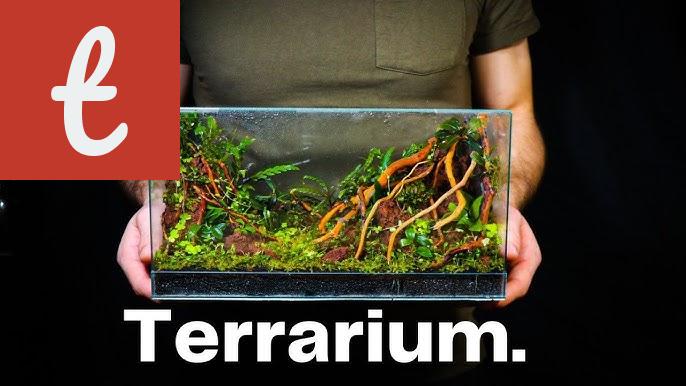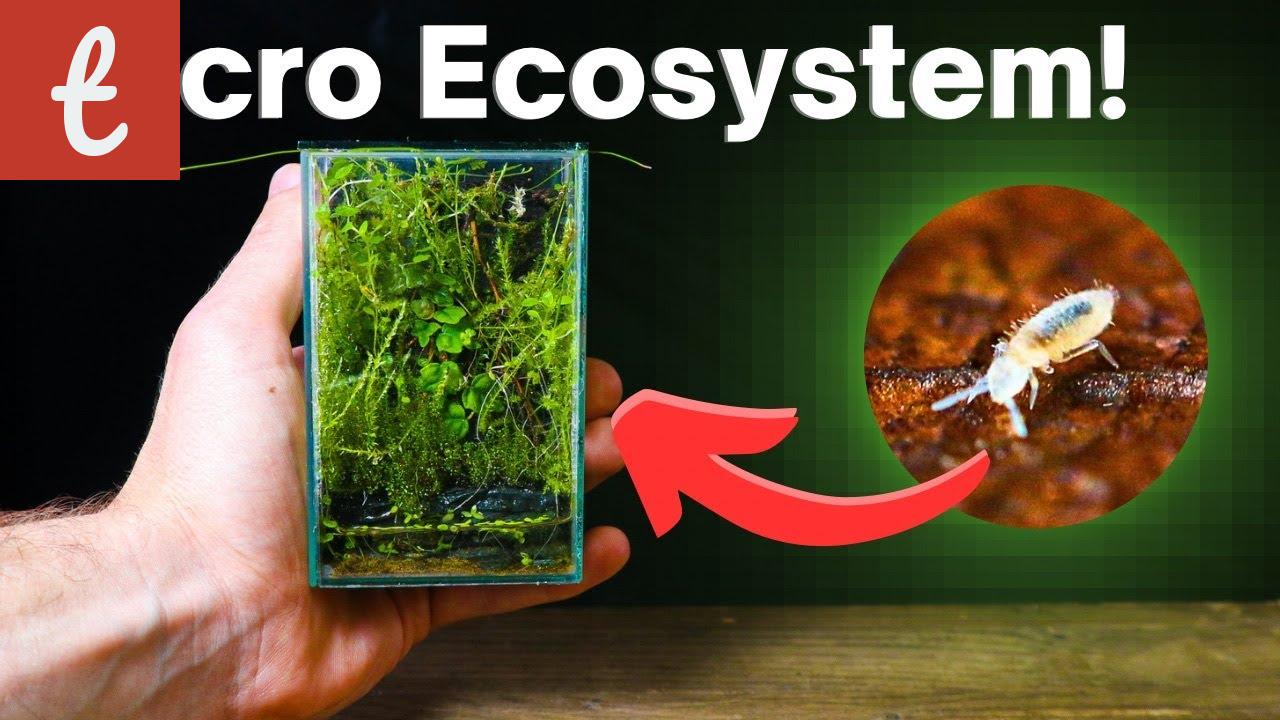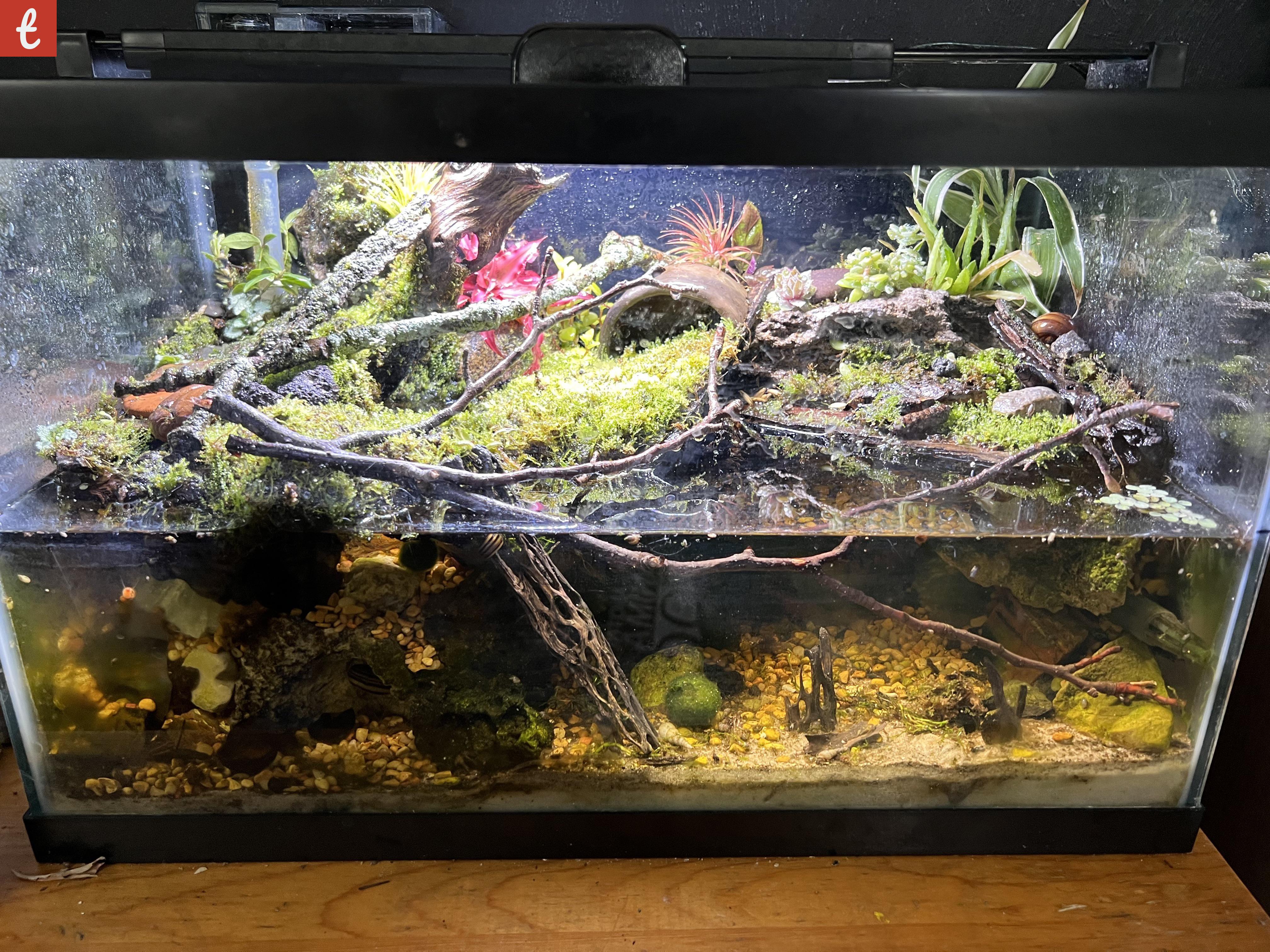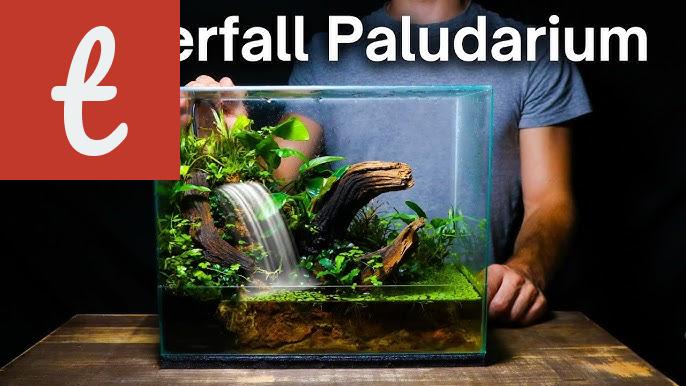Building a Miniature Paludarium: The Ultimate Guide
Are you a nature lover looking to create a stunning miniature ecosystem in your home? If so, building a paludarium might be the perfect project for you! A paludarium is a unique combination of a terrarium and aquarium, creating a habitat that can house both aquatic and terrestrial plants and animals. Whether you are a beginner or an experienced hobbyist, this ultimate guide will provide you with all the information you need to create your very own miniature paludarium.
Before venturing into the world of paludariums, it's important to understand the key components and considerations involved. One of the first steps is selecting the right container for your paludarium. A clear glass or acrylic tank with a lid is ideal, as it allows for easy viewing and maintenance. The size of the tank will ultimately depend on the space you have available, but a larger tank will provide a more stable environment for your plants and animals.
- Research your desired plants and animals:
- Install proper lighting and heating:
Researching the plants and animals that you want to include in your paludarium is crucial to its success. Choose plants that are adaptable to both submerged and terrestrial environments. Some popular choices include ferns, mosses, orchids, and carnivorous plants. When it comes to animals, opt for small creatures such as tropical fish, small frogs, or aquatic insects. Ensure that these species are compatible and thrive in similar environmental conditions.
Proper lighting and heating are essential for maintaining a healthy paludarium. Plants typically need a balance of both natural and artificial light sources. Consider using full-spectrum LED lights to mimic natural sunlight. Additionally, some plants may require supplemental heating to thrive, especially if you live in a colder climate. Use a submersible aquarium heater or heat mat to regulate the temperature within the paludarium.
Water quality is another critical factor to consider when creating a paludarium. Use dechlorinated water or natural spring water to fill the aquatic portion of the tank. Maintaining water parameters such as pH, temperature, and hardness is crucial for the health and well-being of the aquatic plants and animals. Regular water testing and proper filtration are essential to ensure a stable and thriving ecosystem.
Creating a natural-looking environment is key to the aesthetic appeal of your paludarium. Start by adding a layer of substrate at the bottom of the tank. Use a combination of aquarium soil, sand, and gravel to create a diverse and visually appealing landscape. Next, arrange the rocks, driftwood, and other decorative elements to create areas for both aquatic and terrestrial plants to thrive.
Maintaining a paludarium requires regular care and maintenance. Conduct routine checks of the temperature, humidity, and lighting conditions within the tank. Trim and prune the plants as needed, removing any dead or decaying leaves. Monitor the water parameters and perform regular water changes to ensure a healthy environment for your plants and animals.
Now that you have a comprehensive understanding of how to build and maintain a miniature paludarium, it's time to start planning and designing your own unique ecosystem. Remember to research, select appropriate plants and animals, and create a visually appealing and balanced environment. With proper care and attention, your paludarium will become a captivating centerpiece in your home, showcasing the beauty of nature within a miniature world of your own making.
The Art of Creating Tiny Ecosystems: Mini Paludariums
In recent years, the world of gardening has seen a surge of interest in creating mini ecosystems. One popular trend in this space is the art of paludariums - miniature aquatic and terrestrial environments enclosed in glass containers. These tiny ecosystems not only provide a fascinating view into the natural world but also offer a unique and creative way to bring nature into our homes.
Paludariums combine the beauty of aquariums and terrariums, allowing you to create a harmonious blend of water, land, and plants. The word "paludarium" comes from the Latin word "palus," which translates to "swamp" or "marsh." These pocket-sized ecosystems resemble the lush environments found in wetlands, rainforests, or other water-rich ecosystems.
- Benefits of Mini Paludariums:
- Improved indoor air quality: Plants act as natural air purifiers, removing toxins and releasing oxygen into the air.
- Stress reduction: Being close to nature has a calming effect on our minds and helps reduce stress and anxiety.
Creating a mini paludarium is a thrilling and creative process. The first step is to choose a suitable container - a glass enclosure with a tight lid works best to maintain the necessary humidity. It's essential to consider the size and shape of the container to ensure it can accommodate both aquatic and terrestrial plants.
When it comes to plants, variety is key. Select a mix of aquatic plants, such as ferns, mosses, and miniature water lilies, and terrestrial plants like mosses, orchids, or creeping ficus. These plants will not only add beauty to your paludarium but also help maintain the balance of the ecosystem.
Design and Placement: Creating a visually appealing paludarium is an art in itself. Consider the placement of plants, rocks, and driftwood to create a natural and harmonious habitat. The foliage should be arranged in a way that simulates layers found in a typical rainforest or wetland area.
After designing the layout, establishing the right environment is crucial. Maintain a balance of humidity, light, and temperature within the paludarium. Utilize appropriate lighting that supports plant growth while avoiding excessive heat buildup.
Maintenance: To keep your mini paludarium thriving, regular maintenance is necessary. Monitor the water quality, maintaining proper filtration and regular water changes to prevent the buildup of harmful toxins. Trim and prune plants as needed to keep them healthy and prevent overcrowding.
- Final Thoughts:
- Mini paludariums are a wonderful way to immerse yourself in the world of nature without leaving the comfort of your home.
- With their mesmerizing beauty and ability to create a self-sustaining ecosystem, these tiny worlds are perfect for both plant enthusiasts and those looking for a unique and intriguing hobby.
So, why not channel your creativity and try your hand at creating a captivating mini paludarium today? Embark on a journey into the wonders of nature and discover the joy of maintaining your very own tiny ecosystem.
Main Title: Step-by-Step: How to Make Your Own Miniature Paludarium
If you're looking for a unique and captivating addition to your home or office, consider creating your own miniature paludarium. A paludarium is a type of vivarium that combines both land and water elements, allowing you to create a beautiful and self-contained ecosystem. Not only is a paludarium aesthetically pleasing, but it also provides an interesting and educational experience for both children and adults.
To create your own miniature paludarium, follow these steps:
- List item 1: Choose the perfect container: Start by selecting a suitable container for your paludarium. It can be a glass aquarium, a terrarium, or any other transparent container that can hold water without leaking. Make sure to choose a size that fits the available space and complements your desired design.
- List item 2: Plan the layout: Before adding any materials, think about how you want your paludarium to look. Consider the types of plants and animals you want to include, as well as the overall theme or aesthetic. Sketch out a rough design or use a computer program to visualize the layout.
Once you've chosen your container and planned the layout, it's time to start building your miniature paludarium. Here's how to do it:
1. Prepare the base: Place a layer of gravel or small rocks at the bottom of your container. This will provide drainage and prevent water from pooling. Ensure that the layer is evenly spread and covers the entire base.
2. Add the substrate: The substrate is the material that plants will grow in. Choose a substrate that suits the types of plants you want to include. Some popular options are potting soil, coco coir, or a mixture of both. Spread the substrate evenly on top of the layer of gravel, ensuring there is enough depth for the plants to establish their roots.
3. Create the water feature: Depending on your design, you can add a small pond, a waterfall, or a stream. Use a small water pump to circulate the water and keep it fresh. If you want to include aquatic plants or animals, choose a container that is deep enough to accommodate them.
4. Select and place plants: Choose plants that thrive in both wet and dry conditions. Look for species that are compatible with both the water and land portions of your paludarium. When placing the plants, consider their size, growth habits, and compatibility with other species. Arrange them in a visually pleasing way, using rocks, sticks, or driftwood to add structure and variety.
5. Introduce animal inhabitants: Once your paludarium is established, you can add animal inhabitants such as small fish, newts, frogs, or even turtles. Make sure to research the specific needs and requirements of the animals you choose and provide them with appropriate food, water, and hiding places.
6. Maintain and care for your paludarium: Regular maintenance is crucial to keeping your paludarium healthy and thriving. Monitor the temperature, humidity, and lighting conditions to ensure they are suitable for your plants and animals. Conduct regular water changes and clean the glass to prevent algae growth. Trim and prune the plants as needed to maintain their health and control growth.
Creating your own miniature paludarium can be a rewarding and fulfilling experience. Remember to research the specific needs of your chosen plants and animals before you start and make adjustments as necessary. With proper care and maintenance, your miniature paludarium will become a fascinating centerpiece in your home or office.

Explore the Magic of Miniature Paludariums: A Complete Guide
Have you ever wanted to experience the beauty and tranquility of the natural world right in your own home? If so, then miniature paludariums might be the perfect solution for you. These captivating displays combine the best of both aquatic and terrestrial environments, creating a mini ecosystem that is as stunning as it is functional. In this complete guide, we will dive into the world of paludariums and show you everything you need to know to create your own enchanting miniature oasis.
First, let's break down the term "paludarium". It is derived from the Latin words "palus" meaning swamp or marsh, and "arium" meaning a place. In simpler terms, a paludarium is essentially an enclosed container that mimics the natural habitat of plants, animals, and aquatic creatures found in wetlands or rainforests. It is a true marvel of design, as it combines aquatic and terrestrial elements to create a harmonious and self-sustaining ecosystem.
- List item 1: Choosing the right container
- List item 2: Selecting the perfect plants and animals
When it comes to creating a miniature paludarium, one of the most critical choices you'll make is selecting the right container. The size and shape of the container will determine the overall design possibilities and the types of plants and animals that can thrive in your paludarium. Popular choices include glass aquariums or terrariums, mason jars, and even repurposed vintage glass containers. It's essential to ensure that the container is watertight and has proper ventilation to maintain the right humidity levels.
After selecting the container, the next step is choosing the perfect plants and animals. The key is to create a balance between the aquatic and terrestrial components of your paludarium. Aquatic plants such as mosses, ferns, and aquatic grasses can be placed in the water portion, while terrestrial plants like pothos, bromeliads, and orchids can be placed above the waterline. The choice of animals depends on the size of your paludarium, but options range from small fish and shrimp to frogs, snails, and even small turtles.
Creating a paludarium is a multi-step process that includes setting up the water portion, installing a filtration system, creating a substrate for the terrestrial plants, and establishing a lighting system. It's important to recreate the natural conditions and provide the right balance of light, heat, and humidity for your plants and animals to thrive. Regular maintenance including feeding, pruning, and cleaning will help to ensure the long-term health and success of your paludarium.
In conclusion, miniature paludariums are a fascinating way to bring the beauty of nature into your home. By combining aquatic and terrestrial elements, these captivating displays offer a truly unique and mesmerizing experience. Follow this complete guide, and with a little bit of creativity and some careful planning, you'll be well on your way to creating your very own magical miniature paludarium.
Mastering the Art of Mini Ecosystems: Paludariums 101
If you are looking to bring a piece of nature into your living space, then paludariums are the perfect choice. These mini ecosystems combine the beauty of aquatic and terrestrial plants along with aquatic life, creating a captivating display that is both visually appealing and educational. In this article, we will guide you through the basics of paludariums and how to create your own stunning masterpiece.
Paludariums are a unique fusion of a terrarium and an aquarium, where both land and water coexist harmoniously. This captivating combination allows for a diverse range of plant and animal species to thrive in a single habitat. The word "paludarium" is derived from the Latin word "palus," which means swamp or marsh, highlighting the wetland nature of these habitats.
- Enhance the ambience of your living space with a paludarium
- Showcase the interdependence between land and water
Creating a paludarium requires careful planning and attention to detail. To start, you will need a suitable enclosure that provides both land and water areas. This can be achieved using an aquarium tank or a specially designed paludarium tank that is equipped with features like a water filtration system and a built-in land area.
Once you have your tank, it's time to set up the substrate. Use a combination of aquatic-friendly soil for the water area and a well-draining substrate for the land area. Ensure that the water area is deep enough to support the aquatic plants and a have a section that is shallow to accommodate amphibian life. Your choice of plants and animals will depend on the specific environment you want to create, so research the needs and compatibility of different species beforehand.
When it comes to selecting plants for your paludarium, consider a mix of aquatic and semi-aquatic species. Ferns, mosses, and pothos are popular choices for land areas, while water lilies, anubias, and java moss can be used for the water area. Remember to provide adequate lighting and humidity levels to support plant growth.
In terms of aquatic life, the possibilities are endless. From small fish and shrimp to amphibians like frogs and newts, choose species that are suited to the size of your tank and the conditions you can provide. It's important to ensure that you have a balanced ecosystem with the right mix of predators and prey.
Once your paludarium is set up, maintenance is key to its long-term success. Regular monitoring of water quality, temperature, and humidity levels is essential. It's important to maintain proper filtration and perform water changes as needed.
In conclusion, paludariums offer a unique and captivating way to bring nature into your home. Through careful planning and attention to detail, you can create a thriving mini ecosystem that not only adds beauty to your living space but also provides a valuable educational experience. So, why not embark on this fascinating journey and create your very own paludarium masterpiece?




Comments on "Creating A Miniature Paludarium: A Guide To The World's Smallest Ecosystem"
No comment found!